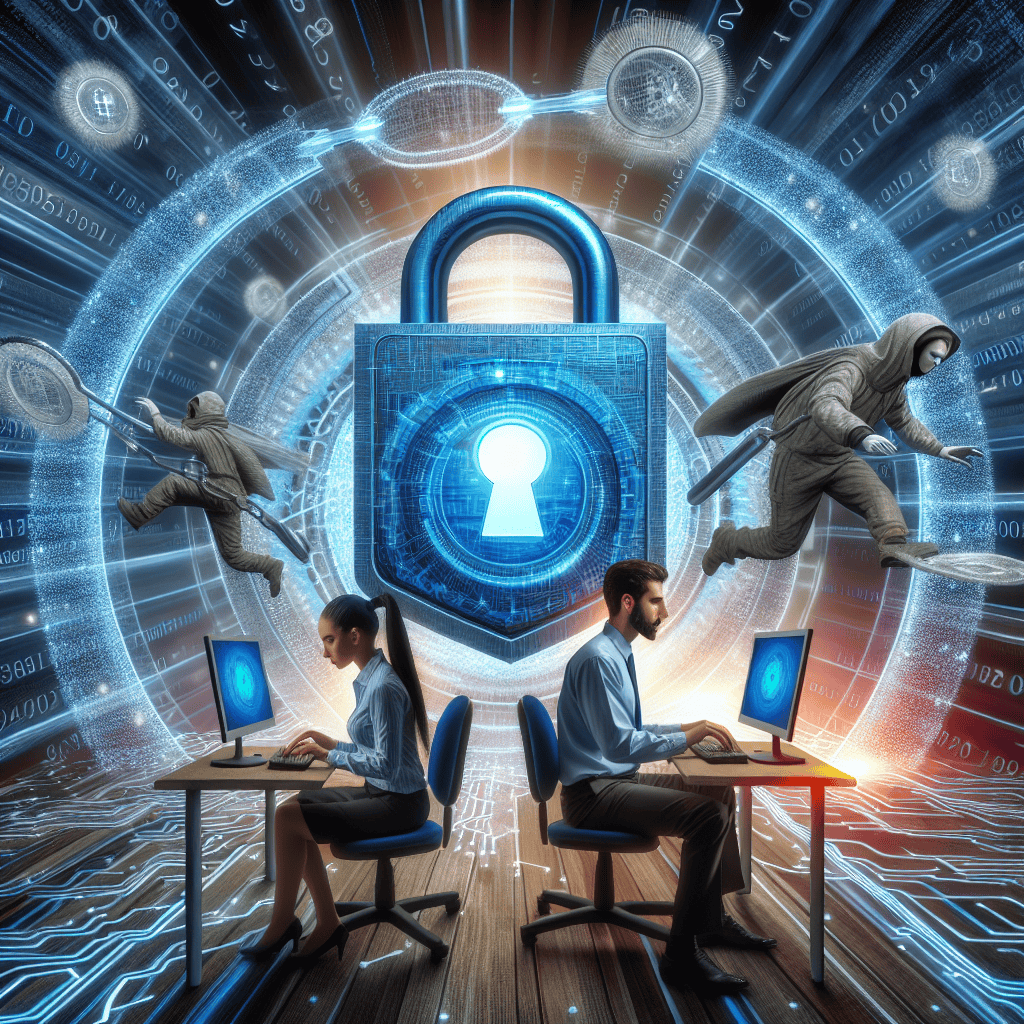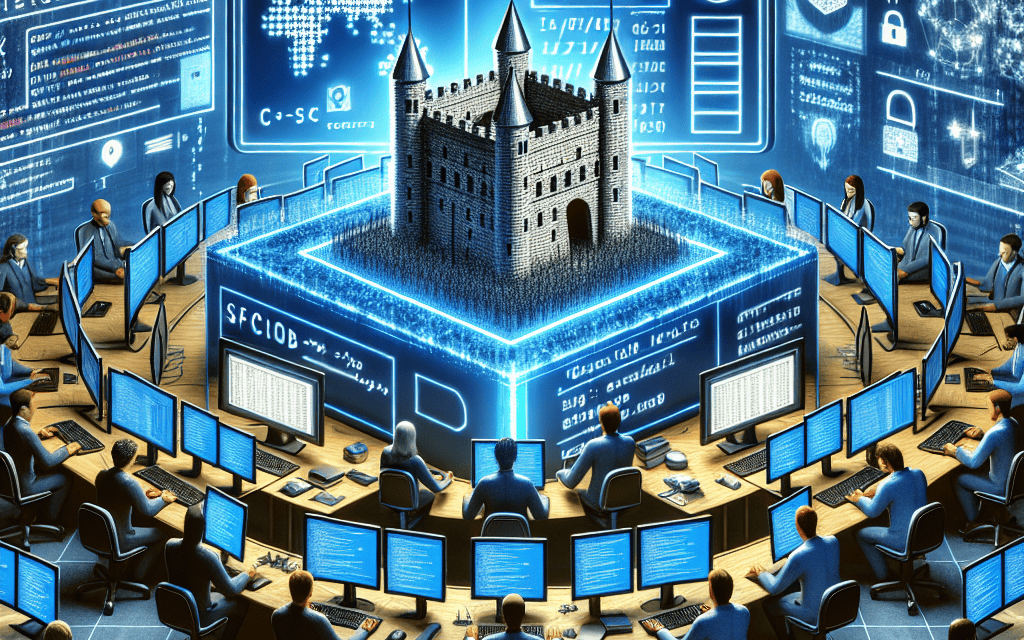Achieving Cybersecurity Victory: The Ultimate Challenge for CISOs

In the rapidly evolving digital landscape, Chief Information Security Officers (CISOs) face the daunting task of safeguarding their organizations against a myriad of cyber threats. As the guardians of cybersecurity, CISOs must navigate complex challenges to protect sensitive data, maintain trust, and ensure business continuity. This article delves into the ultimate challenge for CISOs: achieving cybersecurity victory. We will explore five critical subtopics, each providing valuable insights and strategies to help CISOs succeed in their mission.
1. Understanding the Cyber Threat Landscape
The first step towards achieving cybersecurity victory is understanding the ever-changing threat landscape. Cyber threats are becoming increasingly sophisticated, and CISOs must stay ahead of the curve to protect their organizations effectively.
1.1 The Evolution of Cyber Threats
Cyber threats have evolved significantly over the years, from simple viruses to complex, targeted attacks. Today, cybercriminals employ advanced techniques such as ransomware, phishing, and zero-day exploits to breach organizational defenses. According to a report by Cybersecurity Ventures, global cybercrime costs are expected to reach $10.5 trillion annually by 2025, highlighting the growing threat landscape.
One notable example is the WannaCry ransomware attack in 2017, which affected over 200,000 computers across 150 countries. This attack demonstrated the potential impact of cyber threats on a global scale and underscored the need for robust cybersecurity measures.
1.2 Emerging Threats and Trends
As technology advances, new threats continue to emerge. The rise of the Internet of Things (IoT) has introduced vulnerabilities in connected devices, while the increasing use of cloud services has expanded the attack surface for cybercriminals. Additionally, the growing sophistication of state-sponsored attacks poses a significant challenge for CISOs.
To stay ahead of these threats, CISOs must continuously monitor emerging trends and adapt their strategies accordingly. This includes investing in threat intelligence and collaborating with industry peers to share insights and best practices.
1.3 The Role of Artificial Intelligence in Cybersecurity
Artificial intelligence (AI) is playing an increasingly important role in cybersecurity. AI-powered tools can analyze vast amounts of data to identify patterns and detect anomalies, enabling organizations to respond to threats more quickly and effectively. According to a report by Capgemini, 69% of organizations believe that AI will be necessary to respond to cyber threats in the future.
However, cybercriminals are also leveraging AI to enhance their attacks, creating a cat-and-mouse game between defenders and attackers. CISOs must stay informed about the latest AI developments and incorporate them into their cybersecurity strategies to maintain an edge over adversaries.
1.4 The Importance of Threat Intelligence
Threat intelligence is a critical component of any cybersecurity strategy. By gathering and analyzing information about potential threats, CISOs can make informed decisions about how to protect their organizations. This includes identifying vulnerabilities, assessing risks, and prioritizing security measures.
Effective threat intelligence requires collaboration between organizations, government agencies, and cybersecurity vendors. By sharing information and insights, CISOs can gain a more comprehensive understanding of the threat landscape and develop more effective defenses.
1.5 Case Study: The SolarWinds Cyberattack
The SolarWinds cyberattack in 2020 serves as a stark reminder of the potential impact of sophisticated cyber threats. In this attack, cybercriminals compromised the software supply chain of SolarWinds, a major IT management company, to gain access to the networks of numerous government agencies and private organizations.
This attack highlighted the importance of supply chain security and the need for CISOs to implement robust security measures across their entire ecosystem. It also underscored the value of threat intelligence in identifying and mitigating such threats before they can cause significant damage.
2. Building a Robust Cybersecurity Strategy
Once CISOs have a clear understanding of the threat landscape, the next step is to build a robust cybersecurity strategy. This involves developing a comprehensive plan that addresses the unique needs and challenges of the organization.
2.1 Assessing Organizational Risks
Risk assessment is a critical component of any cybersecurity strategy. CISOs must identify and evaluate the risks facing their organization, taking into account factors such as industry, size, and geographic location. This involves conducting regular security audits and vulnerability assessments to identify potential weaknesses in the organization’s defenses.
By understanding the specific risks facing their organization, CISOs can prioritize security measures and allocate resources more effectively. This ensures that the organization is prepared to respond to potential threats and minimize the impact of any security incidents.
2.2 Developing a Cybersecurity Framework
A cybersecurity framework provides a structured approach to managing and mitigating cyber risks. It outlines the policies, procedures, and technologies that an organization will use to protect its assets and respond to threats. Popular frameworks include the NIST Cybersecurity Framework, ISO/IEC 27001, and the CIS Controls.
CISOs should tailor their chosen framework to the specific needs of their organization, taking into account factors such as industry regulations and business objectives. This ensures that the framework is both effective and practical, enabling the organization to achieve its cybersecurity goals.
2.3 Implementing Security Technologies
Technology plays a crucial role in any cybersecurity strategy. CISOs must invest in a range of security technologies to protect their organization’s assets and data. This includes firewalls, intrusion detection systems, endpoint protection, and encryption solutions.
In addition to traditional security technologies, CISOs should also consider emerging solutions such as AI-powered threat detection and response tools. These technologies can help organizations identify and respond to threats more quickly and effectively, reducing the risk of a successful attack.
2.4 Building a Security-Aware Culture
Technology alone is not enough to achieve cybersecurity victory. CISOs must also focus on building a security-aware culture within their organization. This involves educating employees about the importance of cybersecurity and providing them with the tools and knowledge they need to protect themselves and the organization.
Regular training and awareness programs can help employees recognize potential threats and understand their role in maintaining the organization’s security. By fostering a culture of security, CISOs can reduce the risk of human error and improve the organization’s overall security posture.
2.5 Case Study: The Target Data Breach
The Target data breach in 2013 serves as a cautionary tale for organizations. In this incident, cybercriminals gained access to Target’s network through a third-party vendor, resulting in the theft of 40 million credit and debit card numbers.
This breach highlighted the importance of a comprehensive cybersecurity strategy that includes supply chain security and third-party risk management. By implementing robust security measures and fostering a security-aware culture, organizations can reduce the risk of similar incidents and protect their assets and data.
3. Navigating Regulatory Compliance
In addition to managing cyber threats and building a robust cybersecurity strategy, CISOs must also navigate the complex landscape of regulatory compliance. This involves understanding and adhering to a range of laws and regulations that govern data protection and privacy.
3.1 Understanding Key Regulations
There are numerous regulations that organizations must comply with, depending on their industry and geographic location. Some of the most prominent regulations include the General Data Protection Regulation (GDPR), the California Consumer Privacy Act (CCPA), and the Health Insurance Portability and Accountability Act (HIPAA).
CISOs must stay informed about the latest regulatory developments and ensure that their organization’s cybersecurity strategy aligns with these requirements. This involves implementing appropriate security measures and maintaining comprehensive records of data processing activities.
3.2 The Role of Data Protection Officers
Data Protection Officers (DPOs) play a crucial role in ensuring regulatory compliance. They are responsible for overseeing the organization’s data protection strategy and ensuring that it aligns with relevant laws and regulations. This includes conducting regular audits, providing training and guidance to employees, and serving as a point of contact for regulatory authorities.
CISOs should work closely with DPOs to ensure that their organization’s cybersecurity strategy is compliant with all relevant regulations. This collaboration can help organizations avoid costly fines and reputational damage resulting from non-compliance.
3.3 Implementing Privacy by Design
Privacy by design is a proactive approach to data protection that involves integrating privacy considerations into the design and development of products and services. This approach ensures that privacy is a fundamental component of the organization’s operations, rather than an afterthought.
CISOs should work with product development teams to implement privacy by design principles, ensuring that data protection is considered at every stage of the development process. This can help organizations achieve regulatory compliance and build trust with customers and stakeholders.
3.4 Managing Cross-Border Data Transfers
In today’s globalized world, organizations often need to transfer data across borders. However, this can pose significant challenges in terms of regulatory compliance, as different countries have different data protection laws.
CISOs must ensure that their organization’s cross-border data transfers comply with all relevant regulations. This may involve implementing data transfer mechanisms such as Standard Contractual Clauses (SCCs) or Binding Corporate Rules (BCRs) to ensure that data is protected during transit.
3.5 Case Study: The GDPR and Its Impact
The introduction of the GDPR in 2018 marked a significant shift in the regulatory landscape, with far-reaching implications for organizations worldwide. The regulation introduced strict requirements for data protection and privacy, with severe penalties for non-compliance.
Many organizations faced challenges in achieving GDPR compliance, highlighting the importance of a proactive approach to regulatory compliance. By understanding the requirements of the GDPR and implementing appropriate measures, organizations can protect themselves from potential fines and reputational damage.
4. Responding to Cyber Incidents
No matter how robust an organization’s cybersecurity strategy is, there is always a risk of a cyber incident occurring. CISOs must be prepared to respond quickly and effectively to minimize the impact of such incidents.
4.1 Developing an Incident Response Plan
An incident response plan is a critical component of any cybersecurity strategy. It outlines the steps that an organization will take in the event of a cyber incident, ensuring a coordinated and effective response.
CISOs should work with key stakeholders to develop a comprehensive incident response plan that includes roles and responsibilities, communication protocols, and escalation procedures. Regular testing and updates are essential to ensure that the plan remains effective and relevant.
4.2 The Role of Incident Response Teams
Incident response teams play a crucial role in managing cyber incidents. These teams are responsible for detecting, analyzing, and responding to security incidents, ensuring that the organization can quickly contain and mitigate the impact of an attack.
CISOs should ensure that their organization has a dedicated incident response team with the necessary skills and resources to respond to cyber incidents effectively. This includes providing regular training and access to the latest tools and technologies.
4.3 Communicating During a Cyber Incident
Effective communication is essential during a cyber incident. CISOs must ensure that all relevant stakeholders are informed of the situation and that clear communication channels are established.
This includes communicating with employees, customers, and regulatory authorities, as well as managing media inquiries. By maintaining open and transparent communication, organizations can minimize the impact of a cyber incident on their reputation and maintain trust with stakeholders.
4.4 Learning from Cyber Incidents
Every cyber incident provides an opportunity for learning and improvement. After an incident has been resolved, CISOs should conduct a thorough post-incident review to identify any weaknesses in the organization’s defenses and response procedures.
This review should result in actionable recommendations for improving the organization’s cybersecurity strategy and incident response plan. By learning from past incidents, organizations can strengthen their defenses and reduce the risk of future attacks.
4.5 Case Study: The Equifax Data Breach
The Equifax data breach in 2017 serves as a stark reminder of the importance of effective incident response. In this incident, cybercriminals exploited a vulnerability in Equifax’s web application to gain access to the personal information of 147 million consumers.
The breach highlighted several weaknesses in Equifax’s incident response strategy, including delayed detection and inadequate communication with affected individuals. By learning from this incident, organizations can improve their own incident response capabilities and reduce the risk of similar breaches.
5. The Future of Cybersecurity: Challenges and Opportunities
As technology continues to evolve, so too will the challenges and opportunities facing CISOs. By staying informed about emerging trends and developments, CISOs can position their organizations for success in the future.
5.1 The Rise of Quantum Computing
Quantum computing has the potential to revolutionize the field of cybersecurity. While this technology offers significant opportunities for improving encryption and data protection, it also poses new challenges for CISOs.
As quantum computing becomes more widely adopted, CISOs must stay informed about its implications for cybersecurity and adapt their strategies accordingly. This may involve investing in quantum-resistant encryption solutions and collaborating with industry peers to share insights and best practices.
5.2 The Growing Importance of Cyber Resilience
Cyber resilience is becoming an increasingly important focus for organizations. This involves not only protecting against cyber threats but also ensuring that the organization can quickly recover from any incidents that do occur.
CISOs should work with key stakeholders to develop a comprehensive cyber resilience strategy that includes robust incident response and business continuity plans. By building resilience into their operations, organizations can minimize the impact of cyber incidents and maintain business continuity.
5.3 The Role of Cybersecurity in Digital Transformation
Digital transformation is reshaping the way organizations operate, with significant implications for cybersecurity. As organizations adopt new technologies and business models, CISOs must ensure that cybersecurity is integrated into every aspect of the transformation process.
This involves working closely with other departments to identify potential risks and implement appropriate security measures. By aligning cybersecurity with digital transformation initiatives, organizations can achieve their business objectives while maintaining a strong security posture.
5.4 The Impact of Remote Work on Cybersecurity
The COVID-19 pandemic has accelerated the shift towards remote work, with significant implications for cybersecurity. As employees access corporate networks from remote locations, organizations face new challenges in securing their data and systems.
CISOs must adapt their cybersecurity strategies to address the unique risks associated with remote work. This includes implementing secure remote access solutions, providing training and support to remote employees, and ensuring that security policies are enforced consistently across all locations.
5.5 Case Study: The Colonial Pipeline Ransomware Attack
The Colonial Pipeline ransomware attack in 2021 serves as a stark reminder of the potential impact of cyber threats on critical infrastructure. In this incident, cybercriminals used ransomware to disrupt the operations of a major fuel pipeline, leading to widespread fuel shortages and economic disruption.
This attack highlighted the importance of robust cybersecurity measures for critical infrastructure and the need for organizations to invest in cyber resilience. By learning from this incident, organizations can strengthen their defenses and reduce the risk of similar attacks in the future.
Conclusion
Achieving cybersecurity victory is the ultimate challenge for CISOs in today’s digital landscape. By understanding the threat landscape, building a robust cybersecurity strategy, navigating regulatory compliance, responding effectively to cyber incidents, and preparing for future challenges, CISOs can protect their organizations and ensure business continuity.
As technology continues to evolve, CISOs must stay informed about emerging trends and developments, adapting their strategies to address new risks and opportunities. By fostering a culture of security and resilience, organizations can achieve their cybersecurity goals and maintain trust with customers and stakeholders.





